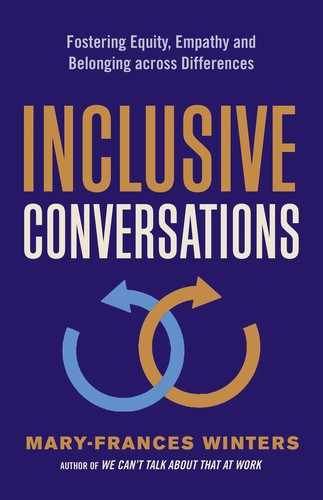CONCLUSION
From Conversation to Action
Ultimately we want to take inclusive conversations to inclusive actions that eradicate the vast societal inequities that persist. We have not mastered the ability to understand the key issues that divide us by race, ethnicity, nationality, gender, gender identity, religion, politics, and age, among other dimensions of difference, because we don’t talk about them. We don’t know how to talk about them, as the examples in the book show. Very rarely are the conditions necessary for success present. The conditions that I have laid out throughout this book are interconnected.
Examining oneself is paramount to any progress we can hope to make in creating a more equitable world. Using metacognitive skills invites us each to think about what we are thinking and to think before we speak. We can avoid damaging words that perhaps we did not mean that might be misinterpreted by the receiver. Self-awareness enhances our capability to understand how we differ from others, the unearned privilege that we might hold that gives us the ability to address our assumptions and biases. We cannot create brave and psychological safe spaces absent critical self-examination that engenders the capacity for trust and empathy.
By creating these key conditions, we are poised to engage in bold, inclusive conversations with those who are different in ways that lead to concerted actions for change. If you follow these recommendations, described in detail throughout the book, there is a good chance of achieving the shared goal of a more inclusive, equitable, and empathetic world.
![]() Acknowledge and discuss the conditions for inclusive conversations at the outset. Admit those conditions that might be missing and propose how to develop them.
Acknowledge and discuss the conditions for inclusive conversations at the outset. Admit those conditions that might be missing and propose how to develop them.
![]() Engage in inclusive conversations for the ultimate purpose of taking action to mitigate systemic inequities.
Engage in inclusive conversations for the ultimate purpose of taking action to mitigate systemic inequities.
![]() Engage in inclusive conversations with children. They are very impacted by world events that engender fear.
Engage in inclusive conversations with children. They are very impacted by world events that engender fear.
![]() Own your identities. We do not live in a “raceless,” “postracial,” or cultureless world. Like it or not, the world has classified you as a certain race and it matters. Understand how your intersecting identities influence the tone, tenor, and outcomes of conversations.
Own your identities. We do not live in a “raceless,” “postracial,” or cultureless world. Like it or not, the world has classified you as a certain race and it matters. Understand how your intersecting identities influence the tone, tenor, and outcomes of conversations.
![]() Talk with yourself. Get to know who you are, your values, beliefs, preferences, and most important, understand why you believe what you believe.
Talk with yourself. Get to know who you are, your values, beliefs, preferences, and most important, understand why you believe what you believe.
![]() Recognize your own fragility, how it shows up and ways to manage it to have inclusive conversations.
Recognize your own fragility, how it shows up and ways to manage it to have inclusive conversations.
![]() Acknowledge your power and privilege and use them to advance inclusion.
Acknowledge your power and privilege and use them to advance inclusion.
![]() Commit to do your part to eradicate injustices as a part of our collective responsibility.
Commit to do your part to eradicate injustices as a part of our collective responsibility.
![]() Develop very specific inclusive behaviors to which you will hold yourself and others accountable.
Develop very specific inclusive behaviors to which you will hold yourself and others accountable.
![]() Take responsibility for your own learning about the histories of different cultures. Don’t put the burden on those from historically marginalized groups to be the teacher. It is exhausting.
Take responsibility for your own learning about the histories of different cultures. Don’t put the burden on those from historically marginalized groups to be the teacher. It is exhausting.
![]() Don’t minimize, or worse dismiss, other people’s lived experiences that may be very different than your own.
Don’t minimize, or worse dismiss, other people’s lived experiences that may be very different than your own.
![]() Extend grace and forgiveness with accountability for diversity, equity, and inclusion missteps.
Extend grace and forgiveness with accountability for diversity, equity, and inclusion missteps.
![]() Do not endorse or engage in conversations that criticize political correctness. Such criticisms are often a way of minimizing, marginalizing, or negating others’ lived experiences.
Do not endorse or engage in conversations that criticize political correctness. Such criticisms are often a way of minimizing, marginalizing, or negating others’ lived experiences.
![]() Resist participating in the cancel culture.
Resist participating in the cancel culture.
![]() Recognize signs of trauma and unplug as you need to. Self-care is critical if you are to engage effectively in DEI work, especially inclusive conversations.
Recognize signs of trauma and unplug as you need to. Self-care is critical if you are to engage effectively in DEI work, especially inclusive conversations.
